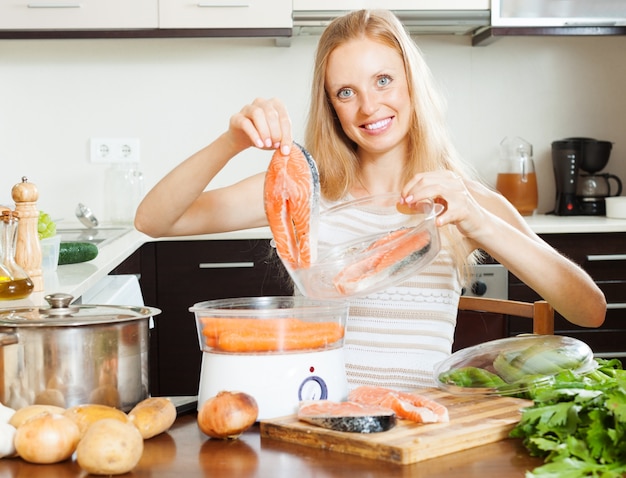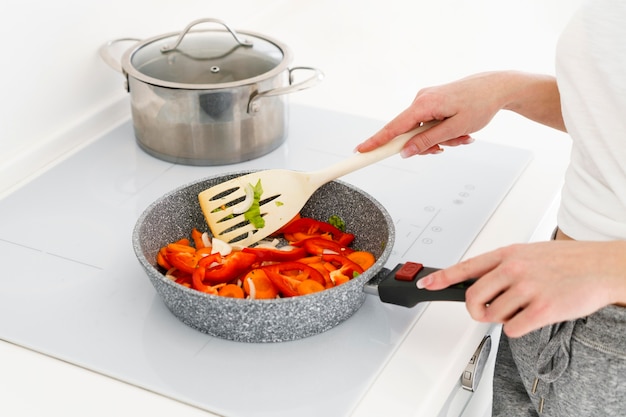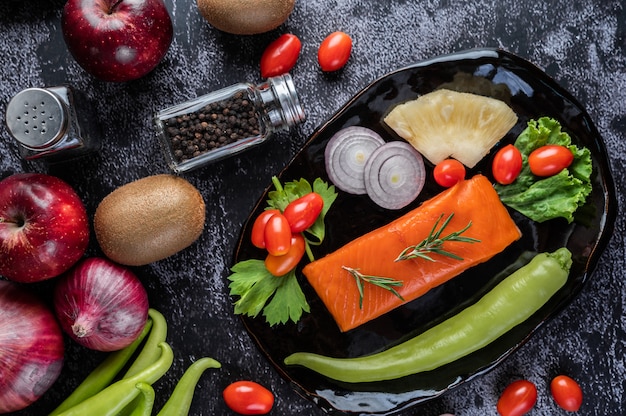Ah, salmon. It's a real crowd-pleaser, isn't it? A healthy, delicious fish that's so versatile, it can be dressed up or down depending on the occasion. But you know the struggle – overcooked, dry salmon is a real disappointment. That's why I'm here to share my tried-and-true guide to cooking perfect salmon on the stovetop. No more dry, flaky disasters!
Part 1: A Little Backstory

Before we dive into the technical details, let me tell you a little story. I used to be a bit of a salmon-cooking novice. My first attempts were, shall we say, less than stellar. The fish would always end up dry and rubbery, and I was left feeling defeated. But over time, I've learned a few tricks and tips that have made all the difference. So, let's get started!
Part 2: choosing the right salmon

First things first, you need to choose the right salmon. Fresh is always best, but if you're using frozen salmon, make sure it's completely thawed before cooking. And while we're on the topic of choosing, consider the type of salmon you're going for. wild-caught salmon tends to have a more intense flavour, while farmed salmon is often a bit milder. It really comes down to personal preference.
Part 3: Getting to Know Your Fillets

Now, let's talk about salmon fillets. The thickness of the fillet plays a crucial role in determining cooking time. A thick fillet will take longer to cook than a thinner one. So, take a moment to assess your fillets before you start cooking. A quick tip: If you're unsure about the thickness, it's always best to err on the side of caution and cook for a slightly shorter time.
Part 4: The Right Tools for the Job
Next up, the equipment. You'll need a good, heavy-bottomed pan for stovetop cooking. Cast iron and stainless steel pans are ideal because they distribute heat evenly and prevent the salmon from sticking. And, of course, make sure your pan is clean – no one wants a burnt crust, right?
Part 5: Preparing the Salmon
Now, let's get those fillets ready. Pat them dry with paper towels – this helps to crisp up the skin and prevents it from steaming too much. You’ve got to love a bit of crispy skin, haven't you? And don’t forget, a little salt and pepper goes a long way. Just a pinch on each side is all you need.
Part 6: Pan-Frying: The Art of the Sizzle
Right, time for the pan-frying. And here’s a crucial point: a hot pan is key! Medium-high heat is your friend. Don't rush it though, you want the pan to be screaming hot before you add the salmon. We’re aiming for that perfect, golden-brown sear that adds a delightful crunch and depth of flavor. While the pan is getting up to temperature, grab a tablespoon or two of olive oil – this will create a lovely, non-stick surface for your salmon.
6.1: Adding the Salmon
Gently place your salmon fillets into the hot pan, making sure to give them some space – we don't want overcrowding. Now, here's where patience is key. Don’t move the salmon around too much. Let it cook undisturbed for a few minutes, until you see that beautiful golden-brown crust develop. For medium-rare salmon, aim for 3 to 4 minutes per side.
Part 7: The Flip
Ahh, the moment of truth! Time to flip those fillets. Be gentle! You don't want to break them. Use a spatula to gently slide the salmon over, making sure it's cooked through on both sides. And remember, those golden brown sear marks are a sign of a perfectly cooked fish!
Part 8: The Perfect Timing
So, how long should you cook that lovely salmon? Well, it depends on the thickness of your fillets and your desired level of doneness. Here’s a handy guide:
| Thickness | Time for Medium-Rare | Time for Medium |
|---|---|---|
| 1 inch | 3-4 minutes per side | 4-5 minutes per side |
| 1.5 inches | 4-5 minutes per side | 5-6 minutes per side |
| 2 inches | 5-6 minutes per side | 6-7 minutes per side |
But remember, these are just guidelines. Always check the salmon by gently pressing on it with a fork. If it flakes easily, it’s cooked to your liking. And please, don’t overcook it! overcooked salmon will be dry and tasteless.
Part 9: Poaching: A Gentle Approach
Now, let's talk about poaching. If you prefer a gentler approach, poaching is a wonderful option. You'll need a saucepan and some poaching liquid. I love using a mixture of white wine, water, and herbs – bay leaves, peppercorns, a lemon slice – the possibilities are endless! Just make sure the liquid is simmering before adding your salmon fillets. Gently cook them for around 5 to 8 minutes for medium-rare salmon, depending on the thickness.
Part 10: Finishing Touches
Right, we're almost there. Now, let's add those finishing touches. A squeeze of lemon juice, a sprinkle of fresh herbs, a drizzle of olive oil – these little details can elevate your salmon to a whole new level. Don't forget the side dishes! A green salad, roasted vegetables, or some mashed potatoes go perfectly with salmon. And if you're feeling fancy, a dollop of crème fra??che or a drizzle of hollandaise sauce can add that extra touch of indulgence.
Part 11: Tips and Tricks
Alright, here are a few more tips to help you become a salmon-cooking master:
- Use a meat thermometer to check the internal temperature of your salmon. It should reach an internal temperature of 125°F (52°C) for medium-rare.
- Don’t overcook the salmon – a little pink in the centre is perfectly fine. It’s a sign of a beautifully cooked fish.
- If your salmon has skin, cook it skin-side down first for a lovely crispy texture.
- Let the salmon rest for a few minutes after cooking. This allows the juices to redistribute, resulting in a more tender and moist piece of fish.
- Don’t be afraid to experiment with different flavours. Try adding garlic, ginger, or a pinch of chilli flakes to your poaching liquid for a bit of a kick.
Part 12: FAQs
Now, let’s address some common questions about cooking salmon on the stovetop.
12.1 Can I Cook Frozen Salmon on the Stovetop?
Absolutely! Just make sure to defrost it thoroughly before cooking. You can defrost it in the refrigerator overnight or use the defrost setting on your microwave. However, be mindful that frozen salmon may take a bit longer to cook through, so keep a close eye on it.
12.2 What Happens if I Overcook Salmon?
Overcooked salmon will be dry and flaky, and it won't be as flavorful. It's best to cook it to medium-rare or medium, and always check the internal temperature using a meat thermometer. But don't fret, it can still be salvaged! Try adding it to a pasta dish or using it for fish cakes.
12.3 How Can I Tell if Salmon is Cooked Properly?
There are a few ways to tell if your salmon is cooked properly. First, check the colour. It should have an opaque appearance, no longer translucent. Next, gently press on the salmon with a fork. If it flakes easily, it’s cooked. You can also use a meat thermometer to ensure it’s reached the desired temperature.
12.4 Can I Cook Salmon with Skin On?
Absolutely! In fact, it's a good idea. The skin helps to prevent the flesh from drying out and can even add a bit of extra flavour. Just make sure to cook it skin-side down first for a nice, crispy texture.
12.5 What Are Some Good Side Dishes to Serve with Salmon?
Salmon is incredibly versatile, so there are endless possibilities when it comes to side dishes. Here are a few ideas:
- Green salad
- Roasted vegetables
- Mashed potatoes
- Couscous
- Quinoa
- Rice
- Asparagus
- Broccoli
- green beans
- Brussels sprouts
- sweet potato fries
Remember, cooking is all about experimentation and finding what works best for you. So don’t be afraid to get creative and try different things. I’m confident that with a little practice, you’ll be whipping up delicious salmon dishes in no time. Happy cooking!
Everyone is watching

Corn on the Cob: The Ultimate Guide to Perfectly Cooked Ears
Healthy MealsAh, corn on the cob. Just the name evokes images of sunny days, barbecues, and that sweet, juicy flavour that ...

Scallops: The Ultimate Guide to Perfect Cooking
Healthy MealsAh, scallops. Those delicate, sweet, and utterly delicious morsels of the sea. They hold a special place in my...

Spaghetti Squash: The Ultimate Guide to Cooking and Serving
Healthy MealsRemember that time you saw spaghetti squash at the supermarket, looking all bumpy and strange, and thought, "W...

Salmon Cooking Times: Perfect Guide for Every Recipe
Healthy MealsLet me tell you, cooking salmon is an art form. It's all about getting that perfect balance: juicy and tender,...

Ham Cooking Time: How Long to Bake, Smoke, or Boil a Delicious Ham
Healthy MealsAh, ham. It's a classic, isn't it? A real crowd-pleaser, especially around holidays. And when done right, it'...
